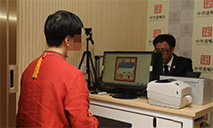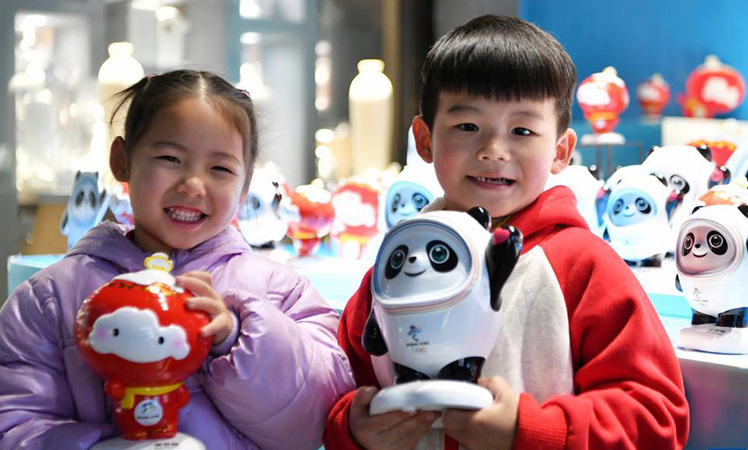Sticking to dynamic zero-COVID approach, China strives for balance of virus containment, economic development

A staff member works at Dongan Auto Engine Co., Ltd. in Harbin, northeast China's Heilongjiang Province, March 23, 2022. (Xinhua/Zhang Tao)
BEIJING, March 25 (Xinhua) -- As night falls in northeast China's Jilin Province, a hard-hit region in the current wave of cluster COVID-19 infections, the temperature drops sharply. Despite the weather, nucleic acid testing continues in Tongguang Road West Community of Changchun, the provincial capital.
Staff members of the neighborhood committee work nearly 20 hours each day, and each medic must conduct nucleic acid tests for approximately 1,000 people a day, all for one purpose -- ensuring safety.
In response to recent cluster infections in multiple regions, China has maintained the policy of "preventing imported cases and domestic resurgences" and adhered to the dynamic zero-COVID approach. It is striving to achieve the best results in epidemic control with minimum costs, and the delicate balance of controlling COVID-19 and promoting economic and social development.
RAPID RESPONSE
Resolute measures, including mass nucleic acid testing, quarantine, working from home, and online education, are put in place to see that COVID-19-related testing, isolation, and treatment services are accessible to anybody in need.
In Jilin, people take both nucleic acid tests and antigen tests for COVID-19, and residents' doors are knocked on to ensure that nobody in need is left unattended.
Virus containment requires rapid response and solidarity among the people. In Changchun University of Science and Technology, teachers formed a volunteer team to deliver hot water to students in need.
While thousands of kilometers away in Quanzhou City of Fujian Province, nearly 60 restaurants jointly launched an initiative to donate meals to epidemic control workers, having delivered more than 10,000 packets.
China has ordered all-out efforts to meet the daily needs of people in locked-down neighborhoods where "green passage" is open to the elderly, children, pregnant women, and patients in severe or critical conditions.
According to the Ministry of Commerce's monitoring, the recent supply of daily necessities in China is generally sufficient with stable prices.

A staff member works at a COVID-19 nucleic acid testing laboratory in east China's Shanghai, March 23, 2022. (Xinhua/Ding Ting)
TARGETED MEASURES
Liang Wannian, head of the COVID-19 response expert panel under the National Health Commission, stressed that the essence of China's dynamic zero-COVID approach is featuring swift and targeted response measures.
The country's latest diagnosis and treatment protocol for COVID-19 patients, its ninth edition, features adjustments regarding case locating and reporting, and patient treatment, aiming to make the epidemic response more science-based and targeted.
According to the new protocol, asymptomatic cases and those with mild symptoms will go to designated quarantine facilities instead of hospitals. The revision, however, does not mean China's epidemic prevention and control will ease, according to officials.
In combatting the recent surge in COVID-19 cases, Shanghai initiated grid screening, or extensive screening of citizens in key districts, industries, and among key groups, through which many asymptomatic cases were identified.
Zhu Jin, Party chief of the Panjiazhai residential compound in Xuhui District of Shanghai, did not go home for four consecutive days, during which she was busy urging residents to take nucleic acid tests, using a loudspeaker.
No infections were reported in four rounds of mass testing, a result that finally made local people at ease, as Panjiazhai is just about a 10-minute walk from a hotel that reported a cluster of infections.
Wu Fan, a member of the Shanghai municipal COVID-19 prevention and control expert team, said grid screening helps clear unnoticed, hidden risks for coronavirus transmission.

A resident buys dumplings at a market in Shenyang, capital of northeast China's Liaoning Province, March 25, 2022. (Xinhua/Wang Yijie)
MINIMIZING IMPACT
While battling to contain the virus, local governments are exploring ways to minimize the epidemic's impact on economic and social development.
Due to COVID-19-related restrictions, many people who previously worked with Hengan, a Fujian-based household paper manufacturer, could not return to their positions, which made labor shortage an immediate headache for the company.
Government authorities came to the company's help by joining Hengan executives in studying details of workers before making arrangements to ensure the smooth passage of workers while epidemic control protocols are well observed.
So far, 90 percent of the company's positions for workers have been filled, bringing many production lines back to operation.
As a base of maize production in China, Jilin has established workgroups to assist farmers in preparing for spring plowing.
In Shenzhen City of southern China, local restrictions are gradually lifted, as the goal of dynamic zero-COVID is basically achieved. Starting Monday this week, the municipal government of Shenzhen and public institutions resumed work, and buses and subways returned to normal operation.
Differentiated epidemic prevention measures have been adopted for enterprises on the production and supply chains.
China's consumer market has been on a steady recovery trend since the beginning of 2022, with retail sales of consumer goods reaching 7.4 trillion yuan (about 1.16 trillion U.S. dollars) in the first two months, growing 6.7 percent from a year earlier.
The consumer market has shown strong resilience and potential, and its trend of expanding scale and optimizing structure has not changed, according to the Ministry of Commerce.
Photos
 Increasingly more young adults in China register wills that include virtual assets
Increasingly more young adults in China register wills that include virtual assets Rapeseed flowers turn NW China's Luoping into picturesque spring wonderland
Rapeseed flowers turn NW China's Luoping into picturesque spring wonderland Why do people in China fall for animated characters like LinaBell and Bing Dwen Dwen?
Why do people in China fall for animated characters like LinaBell and Bing Dwen Dwen? Photo Album: architecture in Beijing merging history and modernity
Photo Album: architecture in Beijing merging history and modernity
Related Stories
- Commentary: Dynamic zero-COVID approach effective, necessary
- Chinese mainland reports 1,301 new local COVID-19 cases
- China's 2nd batch of anti-epidemic supplies arrive in Kiribati
- Commentary: China's balance between epidemic control, economic development safeguards global supply chains
- Most COVID-19 cases in northeast China's Jilin have mild symptoms
Copyright © 2022 People's Daily Online. All Rights Reserved.






